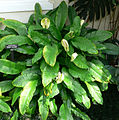Araceae
Family Araceae or Arum family is a big family of herbaceous monocot plant. This family composes 125 genera and 3,750 species. It is distributed from North America, South America, Africa, Europe, Asia to Australia (International Aroid Society, Inc., 2012). The origin and evolution of the Araceae is still poorly known. This might be the herbaceous life form makes them unlikely to fossilize. The oldest reported fossils are pollen grains from the late Barremian-early Aptian, 120 million years ago. The fossil recorded inhabited ponds, lakes or flooded areas. The geographic distribution in the past was driven largely by the global climate (Harendeen and Crane, 1995; Herrera et al., 2008).
IUCN Redlist
Species of this family are herbaceous monocots. Life forms and growth forms of this family are diversify; geophytes, helophytes, epiphytes, hemi-epiphytes, hydrophytes, herbs and vines (Cusimano, 2011; Haigh, 2012; International Aroid Society, Inc., 2012). Stem is aerial and erect, creeping, subterranean, rhizomatous, tuberous, cormous, appressed climbing, scandent, harded and armed, vary to species. Root is often aerial or not, hair like or absent, hydrophytic, helophytic or mesophytic root. Leaves are small to very large, alternate, spiral or distichous, petiole elongate and sheathed at least basally. Blade shape is variegated; oblong, cordate, sagittate, hastate and perforated. Leaf margins are entire, pinnately lobed, or palmately lobed. Main veins are pinnately or palmately veined, the lesser veins are parallel or reticulate. Leaf stomata are present; paracytic, tetracytic, cyclocytic, or anomocytic. Inflorescences are terminal or axillary, solitary or clustered, an unbranched spadix subtended by a single spathe, shape and color vary to species. Spadik is cylindrical shape, flowers are densely, the lower part is often pistillate flower, some part is sterile or without flower, the upper part is often staminate flower, the apex is frequently tapered. Flower is sessile and small, bisexual or unisexual, flower part and shape vary to species. Fruit is berry-like and juicy, sometimes dehiscent or indehiscent, aggregate or not, shape and color are variegated, seed number is only one to many seeds per fruit (Watson and Dallwitz, 1992; Mayo et al., 1997; Mayo et al., 1998; Keating, 2004a; Haigh, 2012).
Family Araceae is classified to division Tracheophyta, class Spermatopsida, subclass Magnoliidae, superorder Lilianae, order Alismatales (The Angiosperm Phylogeny Group III, 2009).
Plant species
Code Scientifice Name Common Name
Ag Aglaonema spp. Chinese evergreen and others
An Anthurium spp.
C Caladium spp.
D Dieffenbachia spp. dumb cane
E Epipremnum aureum pothos
M Monstera spp.
P Philodendron spp.
Ps P. scandens subsp. oxycardium heart-leaf philodendron
Sp Spathiphyllum spp
Sy Syngonium spp. = Nephthytis spp.
Bacterial diseases
Common name Scientific name Plants affected
Bacterial leaf spots Erwinia carotovora subsp. carotovora Ag, An, C, D, E, P, Sy
Bacterial leaf spots E. chrysanthemi Ag, D, E, P, Sy
Bacterial leaf spots Pseudomonas cichorii Ag, An, D, M, P, Sy
Bacterial leaf spots Xanthomonas campestris pv. dieffenbachiae
Red-edge Xanthomonas campestris pv. dieffenbachiae Ps
Soft rot Erwinia carotovora subsp.carotovora. all
Fungal diseases[edit]
Fungal diseases
Common name Scientific name Plants affected
Corynespora leaf spot Corynespora cassiicola A
Gray mold Botrytis cinerea
Botryotinia fuckeliana [teleomorph] A
Myrothecium leaf spot Myrothecium roridum A
Phytophthora stem rot Phytophthora nicotianae var. parasitica
= Phytophthora parasitica
= Phytophthora nicotianae A
Rhizoctonia stem rot Rhizoctonia solani
Thanatephorus cucumeris [teleomorph] A, F
Southern blight Sclerotium rolfsii Athelia rolfsii [teleomorph] A, F
Stem gall Nectriella pironii Kutilakesa pironii [anamorph] A
Viral diseases
Viral diseases
Common name Scientific name Plants affected
Mosaic Cucumber mosaic virus A
Mottle Bidens mottle virus F
Spotted wilt Tomato spotted wilt virus A
https://en.wikipedia.org/wiki/List_of_foliage_plant_diseases_(Araceae)

























